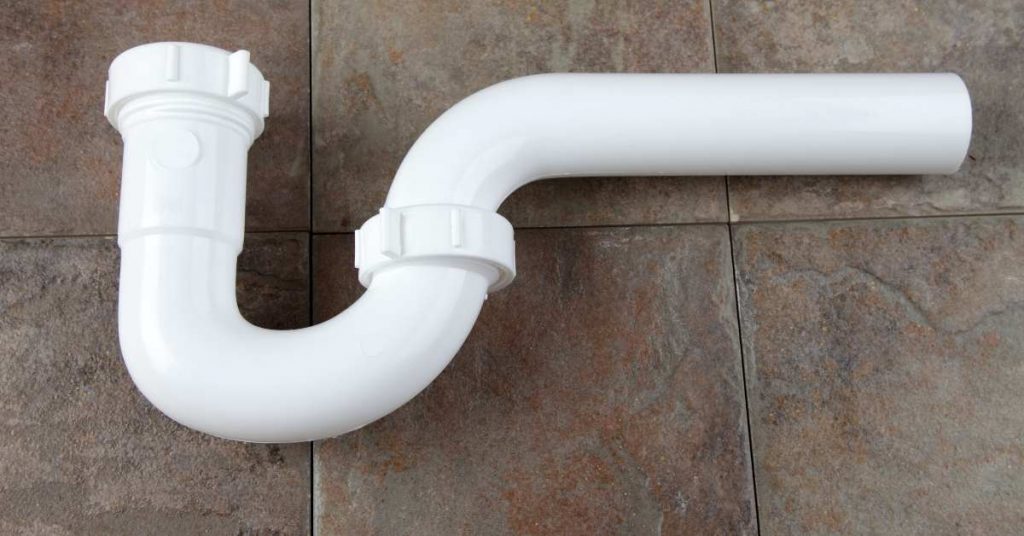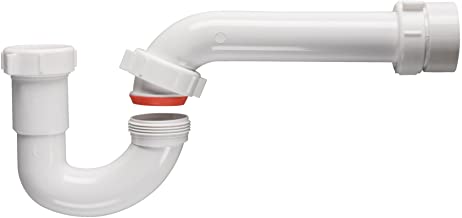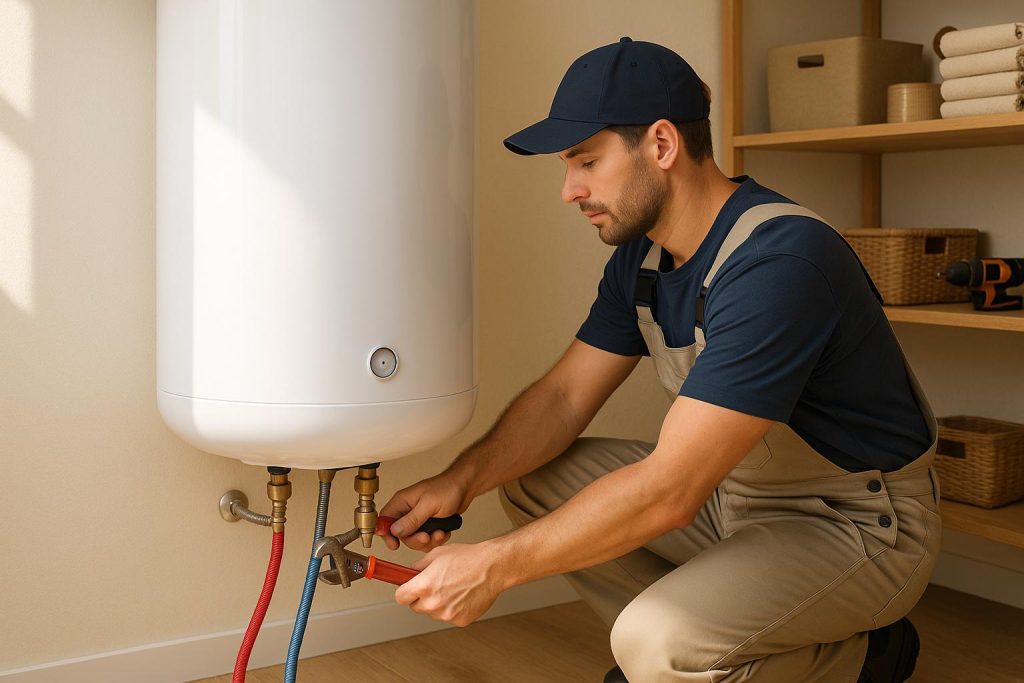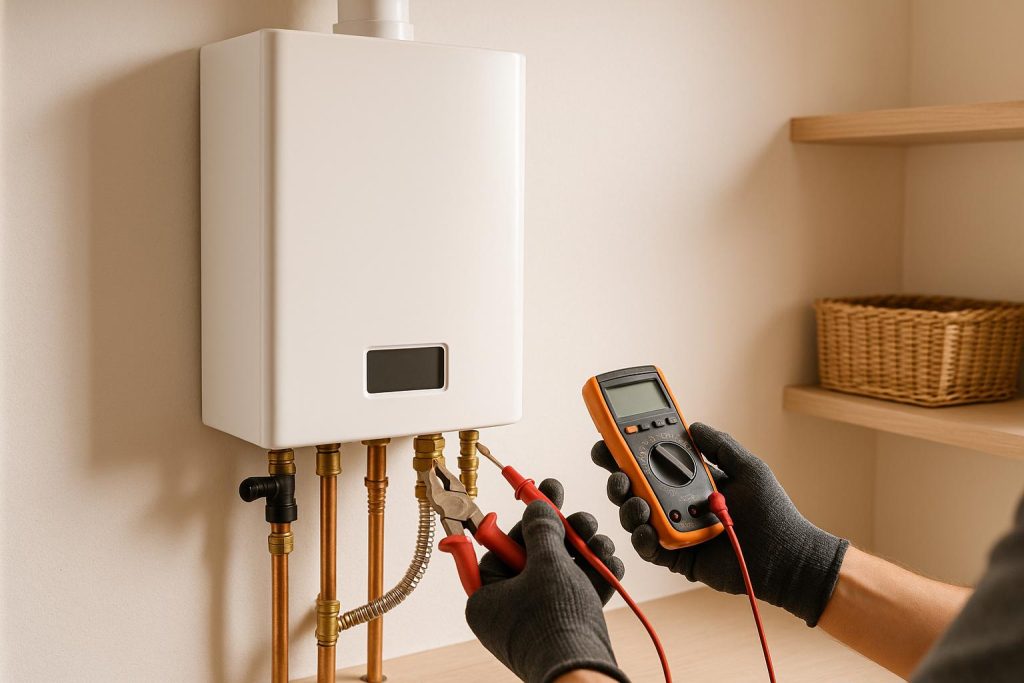Have you ever wondered what the U-bend under your bathroom/kitchen sink or toilet is, and what it is for? That is called a P-trap or drain trap. Every fixture in your house with a drain has one even though some like shower or tub traps not visible.
Most homeowners see this part of the drain but completely ignore it and and don’t understand the principle behind its shape. The shape of the P-trap is actually by design (and required by code) and not accidental or for aesthetics.

A P-trap is the U-shaped bend under drain fixtures. It traps potential drain clogs preventing them from clogging the drainpipe farther away, and also creates a water barrier which prevents sewer gases from coming up through the drain.
The P in the name P-trap is not an acronym for anything. It is named as such since the trap looks like an inverted P. Its short arm is connected to the drainpipe elbow while the long arm is connected to the drain tailpiece and hence the P.
If you have a smelly P-trap, there is accumulated gunk in there, the vent stack is clogged or the trap has no water, forcing sewer gases out through the drain. A clogged vent can cause the P-trap water to be siphoned out, but the water can also evaporate if the drain/fixture has not been used for some time.
If you have a smelly P-trap, pour a cup of baking soda down the drain followed by another cup of vinegar. Wait for about 10 minutes then dump a gallon of hot water down the drain. Unclogging a blocked vent stack will also help with the odor elimination.
Hot water, baking soda and vinegar will in most cases fix a clogged or slow draining P-trap. In some instances, you will need to snake the P-trap but if you are dealing with a clogged kitchen or bathroom sink P-trap you can remove, clean and install it back.
P-Trap vs S-Trap

Before P-traps were introduced, we had S-traps. S-traps were designed to work the way P-traps work but they had their limitations and that is why are no longer used.
The main difference between S-traps and P-traps is really in their shapes. While a drain with a P-traps seems to have an inverted P, a drain with an S-trap forms an S. The S-trap is a P-trap with a second n-bend which forms an S when combined with the first u-bend.
S-traps are illegal in modern plumbing and you are not likely to see one being sold or installed. If you live in an old house, you may still have an S-trap in place.
Check under your kitchen or bathroom sink. If you see an S-trap instead of a P-trap plan to have it replaced as soon as possible.
The main reason S-traps are illegal or bad for your plumbing is that draining water creates a vacuum in the vertical section of the pipe, which siphons water out of the trap. Sewer gases then starts to flow out through the trap, since the water barrier has been broken
How a P-Trap Works

A P-trap is not an optional piece in your plumbing. It is actually required by the building code. It can make your life really easy and even save you thousands of dollars.
Let us look at how it works and what makes it so important.
1. Prevent Sewer Gases in the House
Your kitchen sink drain and all of your bathroom drains (toilets, sinks, bathtubs and showers) are all interconnected. They all drain into the main house drainpipe, which in returns drains the wastewater into the city sewer lines or septic tank.
Given the stale nature of organic wastes around the house, sewage gas smell inside the drainpipes is inevitable. And that is where the P-trap comes in.
A vertical pipe called a vent stack is connected from the main house drainpipe and runs through the roof of the house. This pipe helps to remove the sewer gases smells from the drains as well as allow air into the drains for better draining.
It is however easier for the gases to flow out through toilets or even sink drains. When that happens, your whole house would have a sewage/urine/poop smell.
P-traps are therefore filled with water. The water acts as a barrier, preventing sewer gases from coming up through the drain. Instead, the sewer gases flows out through the vent.
You can actually see the water in the toilet P-trap at the bottom of the toilet bowl. Without that water your bathroom will smell like poop. You cannot see the bathtub or shower P-trap but it is usually just below the drain opening.
When you have a sewer smell in your kitchen or bathroom, most of the time it is caused by an empty P-trap. If the P-trap has no water, sewer gases from the entire house drainpipes (or even septic tank) will flow through it and out in your house.
A clogged vent stack, leaking P-trap or if the fixture has not been used for sometime can all cause the P-trap to be empty. Running water down the drain, unclogging the vent stack or fixing a leaking P-trap will fix the problem.
With a clogged vent stack, it means gases cannot flow out of the drainpipe and air cannot come in. If for instance you drain a bathtub, a vacuum will be created in the drainpipe which will suck water from an adjacent sink P-trap.
If you flush a toilet or drain a bathtub and you hear the sink gurgling, it means water is being sucked out of the P-trap. This is usually caused by a clogged vent.
If you have a sewage smell coming from a drain you have not used in a while, it means the water in the P-trap has evaporated, breaking the barrier. Running water down the drain for a few seconds is enough to restore the evaporated water and fix the problem.
2. Trap Clogs

When you look at a P-trap, you make think it makes your drain ineffective by slowing down the waste as it loops through the bend. However, without the P-trap, plumbing would be a more lucrative business that it is already.
How many times has your kid through a toy in the toilet bowl? And how many times have you thrown things that you should not throw down the kitchen sink drain? I will not ask about the ball of hair in your bathroom sink or shower drain trap.
P-traps helps to trap things that would clog the drainpipe farther away, which would be way harder or even expensive to clog. Pulling a clog from a P-trap is easier than having to dislodge a clog 10 feet away from the drain opening.
Whenever you have a slow draining fixture, most of the time it is caused by a partial clog in the P-trap. If however the sink or bathtub has standing water, you have a fully clogged P-trap.
Another advantage of having a P-trap is that if you accidentally drop something valuable like a ring or necklace down a drain, you have a very good chance of recovering it. Without the P-trap you would loose a lot of valuables down the drain over your lifetime.
Note: If you have a double kitchen sink, the 2 bowls share the same P-trap and drain. the second sink is connected to the first using a piece of pipe called a tee.
3. Flushing Toilets

A toilet P-trap is perhaps more important that other P-traps. Most of us rarely think about it, but a flush toilet is an engineering marvel.
Unlike other drains that have a separate P-trap, a toilet P-trap is integrated into the body of the toilet itself. We are able to flush toilets because of P-traps and most importantly their design.
If you look at your toilet from the side (assuming it is not skirted), you will see that the P-trap has a longer leg and a shorter leg. The long leg is what is connected to the toilet drainpipe.
This shape of the P-trap is what helps to create a siphon when you flush the toilet. When you dump water in the toilet bowl all of sudden, the water fills the toilet bowl as well as the P-trap’s short leg.
When that happens, a vacuum is created in the drainpipe which siphons the waste from the bowl until the level of water in the short leg falls. Air enters the drainpipe and that’s the reason you can hear a gurgle towards the end of the flushing cycle.
It is the action of dumping a big volume of water in the toilet bowl suddenly that creates the siphon effect. Pouring water with a garden hose in the bowl will never trigger a siphon. But a bucket of water dumped in the bowl will. This is the reason toilets need a tank.
How to Fix a Smelly P-trap
A P-trap smells for 3 reasons:
- There is no water in the trap.
- The plumbing vent is clogged.
- There is accumulated organic gunk in the trap
If the smelly fixture has not been used for a while, the water in the P-trap might have evaporated, allowing sewer gases to flow through it. In that case pour about a ¼ gallon of water down the drain and the problem will be fixed.
Check under the kitchen sink to see if the trap is leaking. If it is leaking, tighten the connections a little bit and check if the leak stops. A cracked P-trap will need to be replaced.
In the case of a clogged plumbing vent, water will be sucked out of the P-trap allowing the sewage odor through it. If the fixture or others in the house are draining slowly, and you have a weak flush, you surely have a clogged vent.
Climb to the roof of the house and unclog the vent using a garden hose. If the garden hose fails to do the job get a drain snake.
If the smell is caused by decaying organic gunk in the P-trap, cleaning the P-trap will do the trick. This is how to clean a P-trap and get rid of smell.
- Pour 1 cup baking soda down the drain.
- Slowly add a cup of vinegar
- Wait for 10 minutes then blast hot water through the drain. Don’t use boiling water for ceramic sinks, toilets and bathtubs.
This will completely remove the smell. If you also have a slow draining or clogged P-trap this method will also work very well in clearing it.
How to Replace a P-trap

Replacing P-trap is actually very easy, if you are replacing the one in your kitchen or bathroom sink. A leaking bathtub or shower P-trap is by no any means a simple task, and will most likely need a licensed plumber to replace.
If you need to replace your bathroom or kitchen sink P-trap, here is how to do it:
- Clear the space under your sink.
- Place a small bucket under the P-trap. There will be water in the trap and you will want to collect it, otherwise, it will spill on your floor.
- Disconnect the P-trap. If the P-trap is made of plastic, the connections will be hand tight and you will not need a wrench to loosen them. Metallic P-traps will need a slip-joint pliers or wrench to loosen.
- Connect the new P-trap. While connecting the new P-trap, make sure that the P-trap’s long leg connects to the tailpiece and the short leg to the drain elbow. If the P-trap is connected using washers, make sure you get the correct orientation (tapered end facing the connection).
- Turn on the faucet and check for leaks. Tighten connections in case of any leaks.





